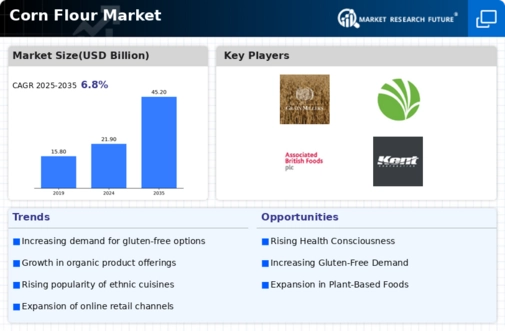Market Share
Corn Flour Market Share Analysis
The corn flour market is experiencing dynamic shifts influenced by various market trends that impact consumer preferences, production methods, and distribution channels. One notable trend is the increasing demand for gluten-free alternatives, driven by rising awareness of gluten intolerance and celiac disease. Corn flour, being naturally gluten-free, has gained popularity as a versatile ingredient in gluten-free baking and cooking, fueling its growth in the market. This trend has prompted manufacturers to expand their product offerings to include certified gluten-free corn flour options, catering to the growing segment of health-conscious consumers seeking gluten-free alternatives.
Moreover, the trend towards healthier eating habits and clean label products has led to the growing demand for non-GMO and organic corn flour. Consumers are increasingly seeking out products made from non-genetically modified organisms (GMOs) and organically grown ingredients, reflecting a broader shift towards sustainable and environmentally conscious consumption. As a result, manufacturers are investing in sourcing non-GMO corn and obtaining organic certifications to meet the evolving preferences of health-conscious consumers, driving the growth of organic and non-GMO corn flour in the market.
Additionally, the rise of plant-based diets and alternative protein sources has created new opportunities for innovation in the corn flour market. Corn flour is a versatile ingredient that can be used to create a wide range of plant-based products, including meat substitutes, dairy alternatives, and plant-based snacks. As consumers increasingly seek out plant-based options for health, environmental, and ethical reasons, manufacturers are exploring new formulations and applications of corn flour to meet the demand for plant-based alternatives in the market.
Furthermore, the globalization of food cultures and the growing popularity of ethnic cuisines have contributed to the diversification of the corn flour market. Corn flour is a staple ingredient in many traditional cuisines around the world, including Latin American, African, and Asian cuisines, where it is used to make tortillas, arepas, chapatis, and other regional specialties. As consumers become more adventurous in their culinary explorations, there is a growing demand for authentic ethnic ingredients like corn flour, driving its adoption and consumption across diverse food cultures and cuisines.
Moreover, technological advancements in food processing and manufacturing have revolutionized the production and distribution of corn flour, leading to increased efficiency, consistency, and product quality. Advanced milling techniques, automation, and quality control measures have enabled manufacturers to produce high-quality corn flour with improved texture, flavor, and nutritional value. Additionally, innovations in packaging and logistics have facilitated the transportation and storage of corn flour, allowing manufacturers to reach new markets and expand their distribution networks.
Furthermore, the COVID-19 pandemic has had a significant impact on the corn flour market, driving changes in consumer behavior, supply chain dynamics, and market trends. The pandemic-induced lockdowns and restrictions led to a surge in home cooking and baking activities as consumers spent more time at home. This increased demand for staple pantry ingredients like corn flour, as consumers sought to experiment with homemade recipes and recreate restaurant-style dishes at home. Additionally, disruptions in the global supply chain and logistics networks resulted in supply shortages and fluctuations in prices, challenging manufacturers to adapt to changing market conditions and ensure the availability of corn flour to meet consumer demand.







Leave a Comment